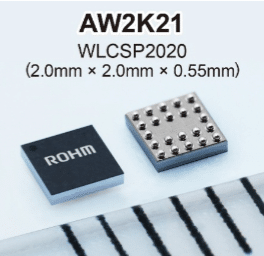Packing dual MOSFETs into a tiny 2.0mm × 2.0mm footprint, it delivers ultra-low 2.0mΩ ON-resistance—ideal for fast-charging smartphones, wearables, and compact electronics.

ROHM has introduced the AW2K21, a 30V N-channel MOSFET in a 2.0mm × 2.0mm package—delivering a class-leading ON-resistance of just 2.0mΩ (typ.). Designed for power-hungry, fast-charging devices like smartphones and wearables, this compact solution is optimized for bidirectional protection and high current flow, tackling modern design challenges in consumer electronics.
The key features of this are:
- 81% smaller footprint vs. conventional 3.3mm × 3.3mm MOSFETs
- 33% lower ON-resistance compared to standard solutions
- Up to 50% lower ON-resistance than similarly sized GaN HEMTs
- Improved thermal performance and reduced power loss
- Faster, more reliable charging in ultra-compact devices
Traditionally, meeting fast-charging demands required two bulky low ON-resistance MOSFETs, taking up valuable board space. The company solves this with a dual-MOSFET common-source configuration, enabling a single device to handle bidirectional protection in charging and power supply circuits. Its proprietary vertical trench structure—with a top-side drain and WLCSP packaging—maximizes chip-to-package area and reduces ON-resistance per unit area.
With a 20A current rating, 28V–30V breakdown tolerance, and minimal resistance, it is tailored for today’s fast-charging, space-constrained applications—from smartphones, tablets, and laptops to VR headsets, drones, and portable printers. It also serves as an ultra-efficient unidirectional protection MOSFET in load switch roles, setting new standards in miniaturization and performance.
Looking ahead, the company is already pushing further, developing a 1.2mm × 1.2mm variant to meet next-gen miniaturization demands. It is available now at $3.5 per unit (sample pricing, tax excluded), marking a new benchmark in compact power device design for a sustainable electronics future.








